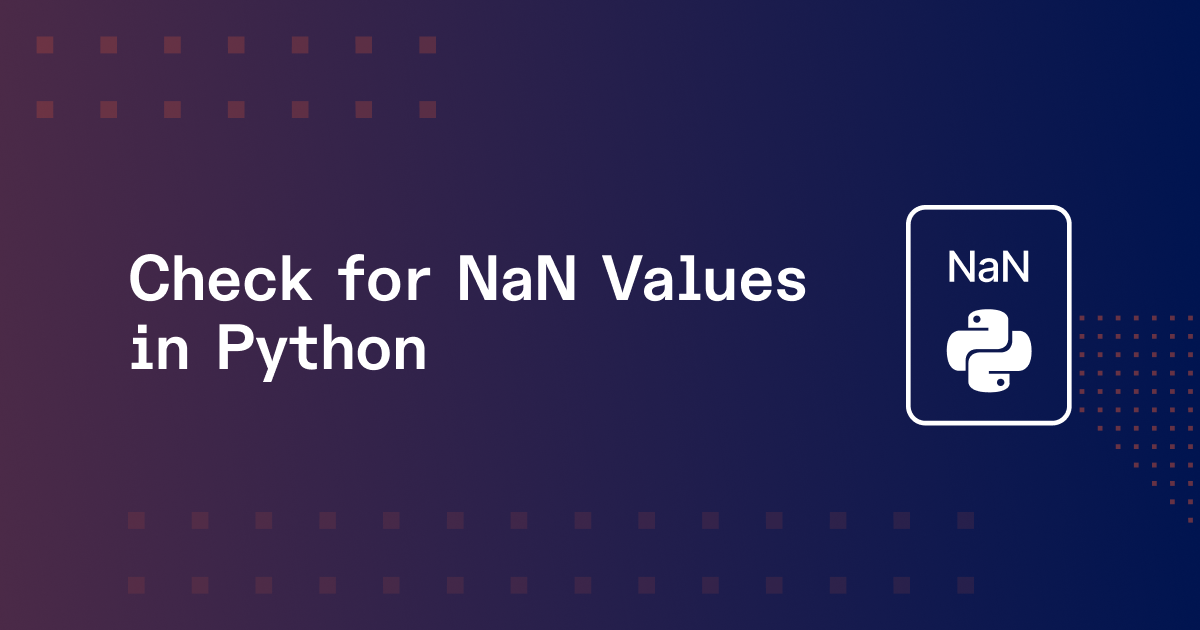Python NaN Check: How to Find NaN Values
Learn various techniques to effectively identify and handle NaN (Not a Number) values in your Python data using pandas and NumPy.
Learn various techniques to effectively identify and handle NaN (Not a Number) values in your Python data using pandas and NumPy.
In Python, NaN stands for "Not a Number" and is used to represent missing or undefined numerical values. This can happen in various situations, such as when you perform calculations with undefined results (like dividing by zero) or when you're dealing with real-world data that has gaps. Here are several ways to detect NaN values in your Python code, helping you handle them appropriately and avoid unexpected errors in your programs.
In Python, NaN stands for "Not a Number" and represents missing or undefined numerical data. Here's how you can check for NaN values:
1. Using math.isnan() (from the math module):
This is a straightforward method to check if a single value is NaN.
import math
value = float('nan')
if math.isnan(value):
print("The value is NaN")
else:
print("The value is not NaN")2. Comparison with itself:
NaN has the unique property of not being equal to itself.
value = float('nan')
if value != value:
print("The value is NaN")
else:
print("The value is not NaN")3. Using NumPy's isnan():
If you're working with NumPy arrays, use this function.
import numpy as np
array = np.array([1, 2, np.nan, 4])
nan_mask = np.isnan(array)
print(nan_mask) # Output: [False False True False]4. Using Pandas' isnull() or isna():
For Pandas DataFrames and Series:
import pandas as pd
data = {'col1': [1, 2, np.nan], 'col2': ['a', 'b', None]}
df = pd.DataFrame(data)
nan_in_df = df.isnull() # or df.isna()
print(nan_in_df)Key Points:
math.isnan() or the self-comparison method if the value might be a string. You'll need to check the type first or use a try-except block.This Python code demonstrates four different methods for identifying NaN (Not a Number) values: using math.isnan(), comparing a value to itself, using numpy.isnan() for arrays, and using pandas.isnull() or pandas.isna() for DataFrames. Each method is illustrated with an example, showcasing how to effectively detect and handle missing data in various data structures.
import math
import numpy as np
import pandas as pd
# --- 1. Using math.isnan() ---
value = float('nan')
if math.isnan(value):
print("1. The value is NaN")
else:
print("1. The value is not NaN")
# --- 2. Comparison with itself ---
value = float('nan')
if value != value:
print("2. The value is NaN")
else:
print("2. The value is not NaN")
# --- 3. Using NumPy's isnan() ---
array = np.array([1, 2, np.nan, 4])
nan_mask = np.isnan(array)
print(f"3. NaN mask for the array: {nan_mask}")
# --- 4. Using Pandas' isnull() or isna() ---
data = {'col1': [1, 2, np.nan], 'col2': ['a', 'b', None]}
df = pd.DataFrame(data)
nan_in_df = df.isnull() # or df.isna()
print("4. NaN values in the DataFrame:")
print(nan_in_df) Output:
1. The value is NaN
2. The value is NaN
3. NaN mask for the array: [False False True False]
4. NaN values in the DataFrame:
col1 col2
0 False False
1 False False
2 True True
Explanation:
math.isnan(): This function directly checks if the given value is NaN.numpy.isnan(): This function is efficient for checking NaNs within NumPy arrays and returns a boolean array.pandas.isnull()/isna(): These functions are used to detect missing values (both NaN and None) in Pandas DataFrames and Series.This code demonstrates the different ways to identify NaN values in Python, providing a practical guide for handling missing data in your projects.
Great notes! Here are some additional points to consider adding:
Causes of NaNs:
Handling NaNs:
dropna() in Pandas can remove rows or columns containing NaNs.~np.isnan(array).fillna() in Pandas allows replacing NaNs with specific values (e.g., mean, median, or a constant).nan_to_num() can replace NaNs with zeros or other values.Important Considerations:
== or != can lead to unexpected results. Always use the dedicated functions (math.isnan(), np.isnan(), pd.isnull(), pd.isna()).float) before checking for NaNs.By including these points, your notes will provide a more comprehensive understanding of NaNs in Python, covering their causes, detection methods, handling techniques, and important considerations.
This table summarizes different methods to check for NaN (Not a Number) values in Python:
| Method | Description
Understanding how to identify and manage NaN values is crucial for writing robust data analysis and manipulation scripts in Python. Whether you're performing calculations, cleaning datasets, or preparing data for machine learning, knowing how to deal with NaNs effectively will prevent unexpected errors and ensure the accuracy of your results. Remember to choose the most appropriate method for your specific data structure and analysis goals.
 Check For NaN Values in Python | This article provides a brief of NaN values in Python. Understanding how to check for NaN values will help you find missing or undefined data in Python.
Check For NaN Values in Python | This article provides a brief of NaN values in Python. Understanding how to check for NaN values will help you find missing or undefined data in Python. Python NaN: 4 Ways to Check for Missing Values in Python ... | Explore 4 ways to detect NaN values in Python, using NumPy and Pandas. Learn key differences between NaN and None to clean and analyze data efficiently.
Python NaN: 4 Ways to Check for Missing Values in Python ... | Explore 4 ways to detect NaN values in Python, using NumPy and Pandas. Learn key differences between NaN and None to clean and analyze data efficiently. 4 Easy Ways to Check for NaN Values in Python | Learn 4 easy ways to check for NaN values in Python. Master these simple techniques to efficiently handle missing data in your projects.
4 Easy Ways to Check for NaN Values in Python | Learn 4 easy ways to check for NaN values in Python. Master these simple techniques to efficiently handle missing data in your projects. Python math.isnan() Method | W3Schools offers free online tutorials, references and exercises in all the major languages of the web. Covering popular subjects like HTML, CSS, JavaScript, Python, SQL, Java, and many, many more.
Python math.isnan() Method | W3Schools offers free online tutorials, references and exercises in all the major languages of the web. Covering popular subjects like HTML, CSS, JavaScript, Python, SQL, Java, and many, many more. Check if the value is infinity or NaN in Python - GeeksforGeeks | A Computer Science portal for geeks. It contains well written, well thought and well explained computer science and programming articles, quizzes and practice/competitive programming/company interview Questions.
Check if the value is infinity or NaN in Python - GeeksforGeeks | A Computer Science portal for geeks. It contains well written, well thought and well explained computer science and programming articles, quizzes and practice/competitive programming/company interview Questions. NaN values in SNAP toolbox - snap - STEP Forum | I was using band math in SNAP toolbox for arithmetic operations. There are NaN values in final output. I tried to solve the equations using Python coding and it gives an output value as ‘1’. What is the problem. I unchecked the band math tab, “Replace Nan and infinity results by”, even then the problem persist and gives the values as NaN. Where am I wrong?
NaN values in SNAP toolbox - snap - STEP Forum | I was using band math in SNAP toolbox for arithmetic operations. There are NaN values in final output. I tried to solve the equations using Python coding and it gives an output value as ‘1’. What is the problem. I unchecked the band math tab, “Replace Nan and infinity results by”, even then the problem persist and gives the values as NaN. Where am I wrong? How to replace
How to replace nan without external libraries when strings are ... | Given a dictionary whose keys are strings and values are a combination of strings, floats, integers and math.nan import math d = {"name": "Ryan", "value": 123.456, "other_value": math.nan} I am trying to convert the nan values to an empty string like this: {'name': 'Ryan', 'value': 123.456, 'other_value': ''} The following gives an error: {k: "" if math.isnan(v) else v for k, v in d.items()} TypeError: must be real number, not str What is the best way to check for nan that doesn’t break o... Using lamba to check 'nan' values A/B Testing Project - Data ... | Link to exercise: https://www.codecademy.com/paths/bi-data-analyst/tracks/dsf-pandas-for-data-science/modules/dsf-aggregates-in-pandas/projects/pandas-shoefly-ab-test I was trying different ways to use lambda, to identify which columns have values and which do not, as I didn’t understand how the hint worked. How can I resolve these errors? (For #1 I read that it is b/c it is showing a series of true/false values, but I thought the program I used was evaluating one row at a time) clicks = lam...
Using lamba to check 'nan' values A/B Testing Project - Data ... | Link to exercise: https://www.codecademy.com/paths/bi-data-analyst/tracks/dsf-pandas-for-data-science/modules/dsf-aggregates-in-pandas/projects/pandas-shoefly-ab-test I was trying different ways to use lambda, to identify which columns have values and which do not, as I didn’t understand how the hint worked. How can I resolve these errors? (For #1 I read that it is b/c it is showing a series of true/false values, but I thought the program I used was evaluating one row at a time) clicks = lam...